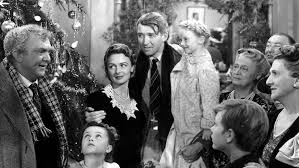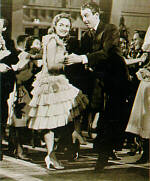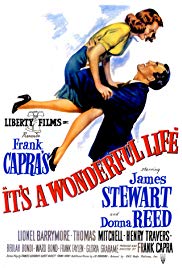IT’S A WONDERFUL LIFE
SUBJECTS — U.S./1913 – 1945;
SOCIAL-EMOTIONAL LEARNING — Male Role Model; Suicide; Breaking Out;
MORAL-ETHICAL EMPHASIS — Responsibility; Citizenship.
AGE: 10+; Not Rated (but suitable for all ages);
Drama; 1946; 130 minutes; B & W. Available from Amazon.com. (There is a colorized version which has been heavily criticized. We don’t recommend it.)
MENU
MOVIE WORKSHEETS & STUDENT HANDOUTS
TWM offers the following movie worksheets to keep students’ minds on the film and to focus their attention on the lessons to be learned from the movie.
Film Study Worksheet for ELA Classes; and
Worksheet for Cinematic and Theatrical Elements and Their Effects.
Teachers can modify the movie worksheets to fit the needs of each class. See also TWM’s Movies as Literature Homework Project.
DESCRIPTION
Set in upstate New York during the first half of the 20th century, “It’s a Wonderful Life” tells the story of a young man who wanted to travel, have adventures, go to college, and be an architect in a big city. But George Bailey’s responsibilities to his family and to his community kept him from leaving the small town where he grew up. He held down a responsible job, raised a family, treated people decently, and helped out whenever he could. One tumultuous Christmas Eve, Bailey is shown how much he has meant to those around him and that happiness can be found in family, friends and fulfilling a responsibility, right in your own home town.
This charming Hollywood classic is almost as fresh today as when it was released in 1946. Many think it’s a better Christmas story than A Christmas Carol. Many say it’s one of the greatest films ever made. If they’re wrong, they’re not off by much. The movie is suitable for viewing at any time of the year.
SELECTED AWARDS & CAST

Selected Awards: 1947 Golden Globe Awards: Best Director (Capra); 1947 Academy Awards Nominations: Best Picture, Best Actor (Stewart), Best Director (Capra), Best Film Editing, Best Sound. “It’s a Wonderful Life” is listed in the National Film Registry of the U.S. Library of Congress as a “culturally, historically or aesthetically significant” film. This film is ranked #11 on the American Film Institute’s List of the 100 Greatest American Movies of All Time (2006).
Featured Actors: James Stewart, Donna Reed, Lionel Barrymore, Thomas Mitchell, Henry Travers, Beulah Bondi, Gloria Grahame, H.B. Warner.
Director: Frank Capra.
BENEFITS OF THE MOVIE
“It’s a Wonderful Life” teaches that everyone can make a difference by living a responsible, caring life. In addition, it presents the counterargument to the contention that young people should follow their own star, leave the community in which they grew up, and go out into the world. In the view of this film, a wonderful life depends upon family, friends and having an honest job that contributes to the community. Finding the right balance between self-fulfillment and dedication to others is a major developmental task, indeed, it is a challenge for all age groups.
This movie contains valuable lessons for the 21st century, especially in these days of rampant corporate and business greed. Bailey, as head of the town’s savings and loan association, keeps his own salary at a reasonable level. He makes sure that the S & L is operated for the benefit of its members and serves the interests of the community. He has a lifelong competition with the town’s richest businessman who, despite his vast wealth, will do anything to make another buck.
POSSIBLE PROBLEMS
Minor. “It’s a Wonderful Life” posits a simplistic religious view of angels in heaven who look after individuals on earth and answer their prayers. This is not intended to be taken seriously. Perhaps a greater problem with the movie is that the villain, Mr. Potter, gets away with his greed and a serious crime, although he is denied any triumph over George Bailey.
Harry Bailey (George’s younger brother) playfully chases the black maid into the kitchen in a scene that would not be permitted today. George Bailey approves a loan from the S & L to a friend (hard not to do in such a small town). In theory and hopefully in practice, this transaction would not be accepted in today’s business environment.
PARENTING POINTS
Ask and help your child to discuss the issues raised in the Quick Discussion Questions.
HELPFUL BACKGROUND
Savings and Loans (S & Ls) developed from the building societies of Great Britain. Beginning in the late 1700s, groups of workingmen would make regular payments to the societies which would provide money to the members for use in building houses. When all members had homes,
the societies would disband. The idea spread to the U.S. in 1831, when a building society was started in Frankford, Pennsylvania. By the mid-1800s, permanent savings and loan associations had been established to serve the average citizen. They accepted savings from individuals and reinvested those funds by lending them to people who wanted to build or buy homes. By 1890, S & Ls could be found in all U.S. states and territories. At one point, savings and loans financed the purchase of more homes nationwide than any other type of financial institution. The term “building & loan,” used in the film, is a less frequently employed name for an S & L.
Most savings associations were mutual organizations, owned by those who had deposits. Account holders were called members and had the right to vote in the selection of directors as their representatives to operate the business. Originally, savings and loans restricted themselves to lending money for the purchase of houses.
During the Great Depression (1929 – 1940) the banking industry was very unstable. Banks were subject to “runs” in which many of their depositors demanded all of their deposits back. Banks that were unable to meet this demand failed. Banks and S & Ls made their money by lending their depositors’ funds to others. Thus, few banks or S & Ls could survive a mass withdrawal by their depositors.
The banking reforms of Franklin Roosevelt’s New Deal brought savings and loans under Federal supervision and insured the shares of their stockholders. This gave the public reassurance in the stability and safety of the industry. In 1989, deposits in S & Ls came to be insured by the Federal Deposit Insurance Corporation (FDIC), the same agency that insures deposits in banks.
Deregulation of the S & L industry in the 1980s spawned abuses that almost wrecked the industry and cost the American taxpayers trillions of dollars. Today the S & L industry is but a shadow of its former self with commercial banks having taken over most of the residential lending market.
From 1918 – 1919 the world suffered a pandemic of influenza. Some 25 million people died of the disease. This was one of the worst worldwide sieges of illness ever suffered by humankind. Usually, flu seasons bring illness to millions but death only to people who have weak respiratory or immune systems. The strain of influenza prevalent in 1918 – 1919 was particularly lethal. It struck hardest at adults 20 to 40 years of age, a group which usually survives influenza. In the U.S. there were about 550,000 deaths. In India it is estimated that 12,500,000 people died from flu during the pandemic. The passing of Mr. Gower’s son at college from influenza is reminiscent of this tragedy.
One of the traditional and antiquated ways of reminding oneself to do something is to tie a string around your finger. The problem is that you have to remember what prompted you to tie the string on your finger.

Some great lines from this film:
“Is it too much to have them work and live and die in two rooms and a bath?”
“Just remember this Mr. Potter, that this rabble you’re talking about, they do most of the working and paying and living and dying in this community… “
“Bread, that this house may never know hunger. Salt, that life may always have flavor. And wine, that joy and prosperity may reign forever…”
DISCUSSION QUESTIONS
1. See Discussion Questions for Use With any Film that is a Work of Fiction.
2. How does the moral of this film apply to today’s more anonymous society in which we haven’t grown up with the people that we live near or work with and don’t know their families?
Suggested Response:
We still should treat people and responsibilities in the same way that George Bailey treated the people of his small town.
3. Compare the lessons of this film, that happiness lies in friends, family and a responsible job in your own hometown, to the contention that it is a good thing to leave your home and culture and develop your talents to the fullest, taught in such films as Billy Elliot, The Jazz Singer, October Sky, or Hoop Dreams.
4. Should George have taken the job that Potter offered him?
5. Compare the themes and plot structure of “It’s a Wonderful Life” and “A Christmas Carol.”
6. Drinking alcohol clouds a person’s judgment as well as their reflexes. Can you tell us how the effects of alcohol clouded George’s judgment on the Christmas Eve shown in the film?
Suggested Response:
Not staying at the bar so that his friends could have taken care of him; driving while intoxicated; seriously thinking about suicide.
7. What is a “run” on a bank?
8. Explain why many banks or S & Ls could not survive a run and how the Federal Deposit Insurance system protects against this.
SOCIAL-EMOTIONAL LEARNING
MALE ROLE MODEL
1. Do you consider George Bailey to be a male role model? Tell us why.
2. Compare Potter with George and his father.
SUICIDE
3. What does this film tell us about suicide?
4. What is the meaning of the scene in which George Bailey jumps into the river, not to commit suicide, but to save Clarence?
BREAKING OUT (CONTRA)
5. How should one balance self-fulfillment and dedication to others?
MORAL-ETHICAL EMPHASIS (CHARACTER COUNTS)
Discussion Questions Relating to Ethical Issues will facilitate the use of this film to teach ethical principles and critical viewing. Additional questions are set out below.
RESPONSIBILITY
(Do what you are supposed to do; Persevere: keep on trying!; Always do your best; Use self-control; Be self-disciplined; Think before you act — consider the consequences; Be accountable for your choices)
1. This film is based upon the premise that everyone makes a difference, good or bad, and that people who live responsible, caring lives make a positive contribution to the lives of those around them. Is this true? What about the other characters in the film such as Uncle Billy, Violet, Mr. Gower, Ernie and Bert?
Suggested Response:
We really don’t know because the story doesn’t focus on them. The point is that everyone can make some difference in the world, as mother, father, son, daughter, in their profession, or by helping others etc.
[The Quick Discussion Questions above also relate to the pillar of Responsibility.]
CITIZENSHIP
(Do your share to make your school and community better; Cooperate; Stay informed; vote; Be a good neighbor; Obey laws and rules; Respect authority; Protect the environment)
2. Without good citizens like George Bailey and his father, what would have happened to Bedford Falls?
3. When this film was made, the development of housing projects was considered something good for the community. Now there is a different view toward the development of housing projects. What is it? What has caused the change?
ASSIGNMENTS, PROJECTS & ACTIVITIES
- See Assignments, Projects, and Activities for Use With Any Film that is a Work of Fiction.
- Have students research the S & L scandal of the 1980s and early 1990s and write an essay on one of the discussion questions that relate to this aspect of the movie.
DVD: There is a DVD version with an excellent extra feature called “A Personal Remembrance” which includes clips of the director, Frank Capra, talking about the film. Another feature of the DVD, “Making It’s a Wonderful Life” gives inside anecdotes about the production which spoil the charm of the film. We suggest skipping this feature.
BIBLIOGRAPHY
In addition to websites which may be linked in the Guide and selected film reviews listed on the Movie Review Query Engine, the following resources were consulted in the preparation of this Learning Guide:
- An online article on “savings and loan association” Encyclopædia Britannica [Accessed October 12, 2002];
- An online article on “influenza epidemic of 1918-19” Encyclopædia Britannica [Accessed October 12, 2002].




